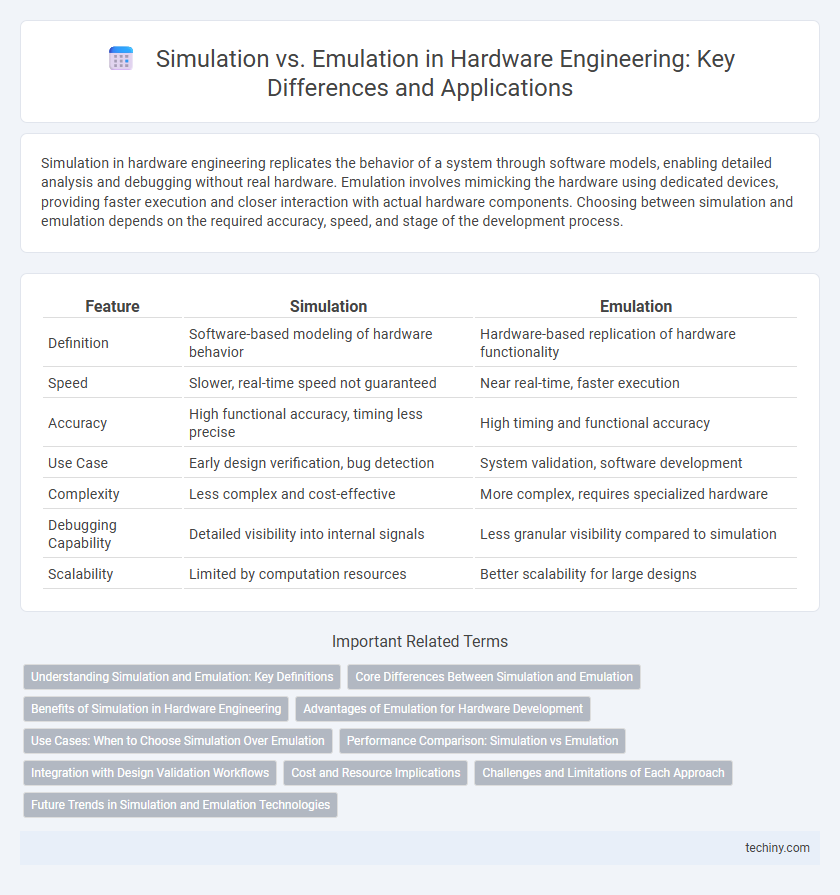Simulation in hardware engineering replicates the behavior of a system through software models, enabling detailed analysis and debugging without real hardware. Emulation involves mimicking the hardware using dedicated devices, providing faster execution and closer interaction with actual hardware components. Choosing between simulation and emulation depends on the required accuracy, speed, and stage of the development process.
Table of Comparison
| Feature | Simulation | Emulation |
|---|---|---|
| Definition | Software-based modeling of hardware behavior | Hardware-based replication of hardware functionality |
| Speed | Slower, real-time speed not guaranteed | Near real-time, faster execution |
| Accuracy | High functional accuracy, timing less precise | High timing and functional accuracy |
| Use Case | Early design verification, bug detection | System validation, software development |
| Complexity | Less complex and cost-effective | More complex, requires specialized hardware |
| Debugging Capability | Detailed visibility into internal signals | Less granular visibility compared to simulation |
| Scalability | Limited by computation resources | Better scalability for large designs |
Understanding Simulation and Emulation: Key Definitions
Simulation involves creating a virtual model of hardware systems to analyze their behavior under various conditions without physical components, emphasizing accuracy in replicating system responses. Emulation uses specialized hardware to mimic the exact functions of a target device, enabling real-time execution and interaction with actual software environments. Both techniques are essential in hardware engineering for validating designs, but simulation focuses on theoretical modeling while emulation prioritizes practical hardware replication.
Core Differences Between Simulation and Emulation
Simulation models hardware behavior by using software to imitate the functionality of circuits and systems at various abstraction levels, enabling early design verification without actual hardware. Emulation involves hardware-based platforms that replicate the system's architecture, providing faster performance and real-time interaction, ideal for validating hardware and software integration. Core differences include speed, accuracy, cost, and scalability, with simulation offering slower but highly detailed analysis, while emulation delivers higher execution speed and practical, system-level testing.
Benefits of Simulation in Hardware Engineering
Simulation in hardware engineering enables early detection of design flaws by replicating circuit behavior without physical prototypes, reducing development costs and time-to-market. It offers flexibility to test multiple scenarios and configurations under varied operating conditions, ensuring robust system reliability. High-level abstraction in simulation simplifies complex hardware verification, enhancing accuracy and enabling seamless integration with software development processes.
Advantages of Emulation for Hardware Development
Emulation enables hardware engineers to test and validate complex system designs with high fidelity by replicating hardware behavior in real-time, significantly reducing development time and costs. It offers the advantage of running software on a virtual hardware platform, allowing for early detection of design flaws and seamless integration testing before physical prototypes are available. Emulation supports scalability and debugging capabilities that surpass simulation, providing accurate timing analysis and enabling hardware-software co-validation in the development cycle.
Use Cases: When to Choose Simulation Over Emulation
Simulation excels in early-stage hardware design for verifying functionality and timing accuracy before physical prototypes exist, allowing thorough testing of complex scenarios with detailed signal-level models. It is ideal for software development environments where hardware models drive virtual platforms, enabling code validation without real silicon. Simulation also supports exhaustive corner-case analysis crucial for debugging intricate logic and performance bottlenecks not easily observed in emulation.
Performance Comparison: Simulation vs Emulation
Simulation generally offers slower performance due to its detailed, cycle-accurate modeling of hardware behavior, which requires significant computational resources and time. Emulation delivers higher performance by leveraging specialized hardware to replicate system functions in real-time, enabling faster verification and debugging of complex designs. For large-scale hardware projects, emulation reduces time-to-market by accelerating test cycles compared to simulation.
Integration with Design Validation Workflows
Simulation enables early-stage verification by modeling hardware behavior with high precision, allowing engineers to detect design flaws before physical prototypes exist. Emulation offers faster, cycle-accurate testing by using FPGA-based platforms that integrate seamlessly with system-level validation tools, accelerating firmware and software development. Combining simulation and emulation within design validation workflows enhances coverage, reduces time-to-market, and ensures robust hardware-software co-design.
Cost and Resource Implications
Simulation consumes fewer hardware resources, making it cost-effective for early-stage hardware design analysis and functional verification but can be slower and less accurate in timing representation. Emulation, requiring dedicated hardware platforms such as FPGAs, incurs higher upfront costs and resource allocation but offers accelerated performance and improved accuracy for validating complex system behaviors in real-time. Choosing between simulation and emulation depends on balancing budget constraints with the need for speed and fidelity in hardware engineering projects.
Challenges and Limitations of Each Approach
Simulation in hardware engineering offers high accuracy by modeling device behavior at a granular level but struggles with slow execution speeds and limited scalability for complex systems. Emulation provides faster real-time testing using hardware platforms like FPGAs, yet it can face limitations in design flexibility and requires significant setup time and cost. Both approaches must address trade-offs between fidelity, speed, and resource demands to effectively validate hardware designs.
Future Trends in Simulation and Emulation Technologies
Future trends in hardware engineering highlight increased integration of AI-driven algorithms to enhance simulation accuracy and reduce verification time. Emulation technologies are evolving with the adoption of high-performance programmable platforms, enabling near real-time testing of complex system-on-chip (SoC) designs. The convergence of cloud-based simulation environments and edge computing accelerates collaborative development and scalability in hardware verification processes.
Simulation vs Emulation Infographic

 techiny.com
techiny.com